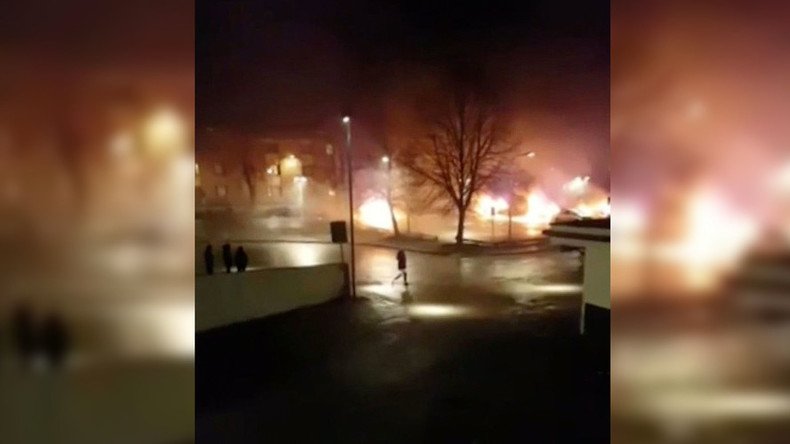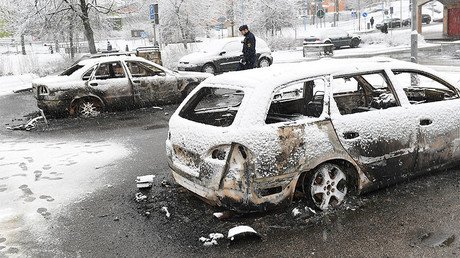Stockholm riots spark online debate over Sweden's 'no-go' areas

A riot in a Swedish suburb which saw cars burned out and police fire warning shots has prompted a heated online debate over what constitutes a ‘no-go zone.’
Swedish newspaper Aftonbladet traced the rise of the ‘no-go’ tag, previously used in the media to describe the area affected by Monday’s riots, Rinkeby, to the publication of a Swedish police report on disadvantaged suburbs.
The December 2015 report did not specifically use the phrase ‘no-go area’, however, and in the wake of Monday’s disturbances, a Swedish journalist prompted an in-depth online debate about the use and accuracy of the term.
Rinkeby, an area in Stockholm, was the scene of street disturbances on Monday. According to police, an arrest escalated into stone-throwing at patrol units and an “officer was hit in the arm and slightly injured”. Police fired warning shots to disperse the crowd and say no injuries were reported as a result of these shots.
Following widespread coverage of overnight trouble in Stockholm, Ivar Arpi, a writer for Svenska Dagbladet, posed the ‘no-go zone’ question on Twitter:
Translation: “What do you think of the concept? What is missing, what catches?"
Är med och pratar "no-go-zoner" i Studio Ett efter 17 i dag. Vad tycker ni om begreppet? Vad missar det, vad fångar det?
— Ivar Arpi (@Ivarpi) February 21, 2017
Swedish police have denied that there are ‘no-go zones’ in the country, reports Sverige Radio. But the term has provoked an outpouring of opinion online. “It is seriously misleading because it really means something else,” said Swedish journalist Daniel Wiklander.
@Ivarpi Det är gravt missvisande eftersom det egentligen betyder något annat. Bara kolla hur saker förvrängs i utländsk rapportering.
— Daniel Wiklander (@DanielWiklander) February 21, 2017
Twitter users questioned whether the term correctly described areas in Sweden or if its use should be restricted to commentary about war zones. Others asked if the phrase was being misused to target and marginalise poorer urban areas.
“I understand the concept [as] the police don't go in there. Such areas are not as well known in Sweden.”
@Ivarpi jag uppfattar begreppet som att polisen inte går in där. Såna områden finns som bekant inte i Sverige.
— Per Skålén (@skalen) February 21, 2017
“I think that semantics are important, as Sweden's situation is discussed in international media and [they] like to use def no-go zones. In the United States no go zones mean a place where police don’t go without a very large [group]”
@trollapan@Ivarpi tycker nog att semantiken är viktig då Sveriges situation diskuteras i int medier och de gärna anv def no-go zones
— M Reynolds (@miafia) February 21, 2017
“‘No-go’ signals war zone and is perhaps too strong”
@Ivarpi "No go" signalerar krigszon och är kanske för starkt. Symptomatiskt att begreppet diskuteras och inte verkliga problem.
— Trollapan (@trollapan) February 21, 2017
“In my view, [a no-go area] a neighborhood where law enforcement and health care cannot move freely without threats and residents take the law into their own hands.”
@Ivarpi I mina ögon en stadsdel där rättsväsende och sjukvård inte kan röra sig fritt utan hotbild och invånare tar lagen i egna händer.
— ⚜PATRIK (@PatrikBatAAr) February 21, 2017
“Worth [looking] up what sort of neighborhoods get the stamp in terms of social class, crime, life of the inhabitants, etc.”
@Ivarpi Värt att ta upp vad för slags stadsdelar som får stämpeln sett till samhällsklass, kriminalitet, livsåskådning hos invånarna osv.
— ⚜PATRIK (@PatrikBatAAr) February 21, 2017
“It captures a feeling, but misses the reality.”
@Ivarpi Det fångar en känsla, men missar verkligheten.
— Mediebruset (@Mediebruset) February 21, 2017
The discussion on ‘no go’ terminology came as Swedish opposition politician Annie Loof attacked government cuts and called for “more police & new legislation” for poorer areas.
READ MORE: Rioters set cars on fire, loot shops in Stockholm suburb (PHOTOS, VIDEOS)
“Insecurity in these areas must be taken seriously now,” Loof said.
Är oacceptabelt det som skett i Rinkeby. Krävs fler poliser & ny lagstiftning. Får ej acceptera att stadsdelar kapas & oskyldiga drabbas.
— Annie Lööf (@annieloof) February 21, 2017













